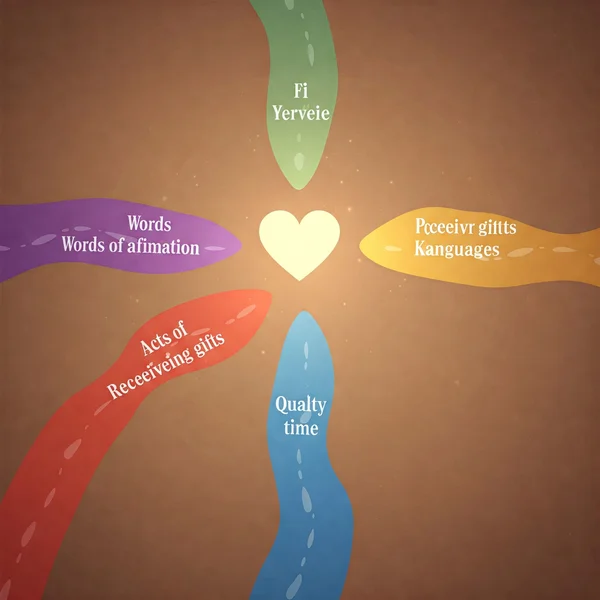What Are the 5 Love Languages? A Complete Guide
Understanding how love is expressed and received is crucial for building strong, lasting relationships. Yet, communication breakdowns are common, often leaving partners feeling disconnected or unappreciated. How do love languages impact relationships? They provide a powerful framework for navigating these challenges. This guide dives deep into the what are the 5 love languages, explaining the core concepts developed by Dr. Gary Chapman and showing you how understanding them can transform your connections. Ready to start understanding yourself and your partner better? Discover your unique communication style with our free love language test.
**What Exactly Are the "5 Love Languages"? **
At its heart, the concept of the 5 Love Languages is simple yet profound. It suggests that people primarily express and experience love in five distinct ways. What is the purpose of knowing love languages? It's about learning to speak your partner's preferred language, ensuring your expressions of love truly land and resonate.

Gary Chapman's Groundbreaking Idea
The concept was popularized by Dr. Gary Chapman in his best-selling book, "The 5 Love Languages: The Secret to Love that Lasts." Through years of counseling couples, he observed patterns in how individuals felt loved and expressed love, categorizing them into these five core types. This framework offers a practical lens for understanding relationships.
How We Give and Receive Love
Think of a love language as your personal emotional communication preference. It's the way you most naturally show affection and, crucially, the way you most deeply feel loved and appreciated by others. Mismatches often occur when we give love in our preferred language, assuming our partner receives it the same way, while their primary language might be entirely different. Recognizing these differences is key to meeting each other's emotional needs.
Why It's Not Just About Romance
While often discussed in the context of romantic partnerships, the principles of the 5 Love Languages extend to all kinds of relationships – with family members, children, friends, and even colleagues. Understanding these love language basics can improve interactions across the board by fostering empathy and clearer communication.
Why Understanding Love Languages Transforms Relationship Communication
Simply knowing the five categories isn't enough; the real power lies in applying this knowledge. How can understanding love languages prevent arguments? By fostering mutual understanding and targeted affection.
Bridging Communication Gaps Effectively
When you know your partner's primary love language, you can tailor your expressions of care in a way they will genuinely understand and appreciate. It moves communication beyond guesswork into intentional, effective connection, improving your overall relationship communication. Understanding different communication styles becomes easier.
Meeting Unspoken Emotional Needs
Often, feelings of being unloved stem not from a lack of effort, but from efforts being expressed in the wrong language. Learning to speak your partner's language directly addresses their core emotional needs, filling their "love tank" and strengthening the emotional bond between you.
Reducing Misunderstandings and Conflict
Many conflicts arise from misinterpreted intentions. Someone whose language is Acts of Service might feel unloved if their partner offers praise (Words of Affirmation) but doesn't help with chores. Knowing the languages helps decode actions (or inaction) and prevents assumptions, leading to better couples communication.
Words of Affirmation
For individuals whose primary love language is Words of Affirmation, words hold immense power. It's about using language to uplift, affirm, appreciate, and empathize.

What Counts as Affirmation?
This goes beyond simple compliments. It includes expressing appreciation ("Thank you for doing that"), offering encouragement ("I believe in you"), kind words, and verbalizing empathy ("I understand how you feel"). It's about expressing love verbally in a positive and supportive way.
Examples of Affirming Language
- "You look amazing tonight."
- "I really appreciate you taking care of dinner."
- "I'm so proud of the way you handled that situation."
- "Hearing your perspective helps me understand."
- Frequent "I love you's."
The Impact of Positive Words
For someone who thrives on affirmation, positive words are like emotional oxygen. Conversely, harsh criticism or unkind words can be particularly devastating. Their emotional needs are deeply tied to verbal expression. You can explore more ways to connect through our love language basics guide.
Acts of Service
For those whose primary language is Acts of Service, actions truly speak louder than words. They feel most loved when others do thoughtful things for them.

Actions Speak Louder Than Words
This language centers on a partner willingly going out of their way to ease the responsibilities or burdens of the other. It's about demonstrating love through helpful actions and expressing love through doing.
Meaningful Actions vs. Routine Chores
While helping with chores can be part of it, the key is the spirit behind the action. It should be done out of love and a desire to help, not obligation. Thoughtful gestures that anticipate needs are particularly impactful. What are acts of service examples? Think beyond the mundane.
Examples of Showing Love Through Service
- Cooking a meal, especially when they're tired.
- Taking care of a task they dislike (like doing the dishes or taking out the trash).
- Running an errand for them.
- Fixing something that's broken.
- Having the coffee ready in the morning.
Receiving Gifts
This love language is often misunderstood. It's not about materialism, but about the thoughtfulness and effort behind the gift.
More Than Materialism: The Symbolism of Gifts
For someone whose language is Receiving Gifts, a gift is a tangible symbol of love, thought, and affection. It shows they were remembered and valued. The cost is often irrelevant; it’s the act of receiving love in a physical form that matters.
What Makes a Gift Meaningful?
A meaningful gift demonstrates that the giver truly knows and cares about the recipient's preferences and desires. It shows effort, planning, and consideration. It meets their emotional needs for feeling seen and cherished.
Examples of Thoughtful Gift-Giving
- A small item they mentioned wanting weeks ago.
- A souvenir from a trip, showing you thought of them while away.
- Their favorite snack or flower, just because.
- A handmade card or item.
- Tickets to an event they'd enjoy.
Quality Time
This language is all about giving someone your undivided attention. It’s about being fully present and engaged when spending time together.

The Essence of Undivided Attention
For someone whose primary language is Quality Time, simply being in the same room isn't enough. They crave focused attention – no phones, no TV, no distractions. It fosters a deep sense of connection and meets their partner's needs for presence.
Quality Conversation vs. Just Being Present
Quality Time often involves Quality Conversation – sharing thoughts, feelings, and experiences in a meaningful way. It also includes Quality Activities – doing something together that both enjoy, creating shared memories.
Examples of Creating Quality Moments
- Going for a walk together with phones put away.
- Having a dedicated "date night."
- Cooking or doing a hobby together.
- Having deep conversations about your day or future dreams.
- Simply sitting together and talking without interruptions. Find out if this is your primary need by taking the official love language quiz.
Physical Touch
This language is about expressing and receiving affection through physical contact. It's a powerful emotional connector for many.
The Power of Human Connection Through Touch
For those with Physical Touch as their primary language, non-verbal cues like hugs, holding hands, and gentle touches communicate warmth, safety, and love more effectively than words or actions might. It's a fundamental way of expressing love and receiving love.
Appropriate Touch in Different Contexts
The type and appropriateness of touch vary depending on the relationship and situation. It can range from intimate gestures in a romantic relationship to comforting hugs between friends or family. It fosters a tangible connection.
Examples of Expressing Love Physically
- Hugging hello and goodbye.
- Holding hands while walking or watching TV.
- A gentle back rub.
- Sitting close together on the couch.
- A comforting arm around the shoulder during a tough time.
How Knowing the 5 Love Languages Helps You (and Your Partner)
Understanding this framework isn't just academic; it has real-world benefits for personal growth and relationship health.

Gaining Self-Awareness in Expressing Needs
Identifying your own primary love language helps you understand why certain things make you feel loved (or unloved) and empowers you to communicate your emotional needs more clearly. This self-awareness is crucial for personal growth.
Developing Empathy for Your Partner's Perspective
Knowing your partner's love language fosters empathy. You begin to understand their reactions and desires from their viewpoint, not just your own. This deepens understanding relationships and helps you meet your partner's needs more effectively.
Identifying Primary Languages
While reading this guide is helpful, truly pinpointing your and your partner's primary languages is the essential first step. How can I find out my love language? While self-reflection helps, the best way is often through a dedicated assessment like our comprehensive 5 love languages test.
Start Your Journey to Better Understanding with the Love Languages
The 5 Love Languages – Words of Affirmation, Acts of Service, Receiving Gifts, Quality Time, and Physical Touch – offer a transformative lens for viewing our most important relationships. Understanding these concepts is the foundation for improving relationship communication, deepening intimacy, and ensuring your expressions of love truly connect. It’s about learning to speak the language that resonates most deeply with the heart of the one you care about.
Ready to unlock deeper connection and improve your relationship communication? Discover your unique love language profile today. Take the free Love Language Test now!
What are your initial thoughts on the five love languages? Which one do you think might be yours? Share in the comments below!
Your Questions Answered
Here are answers to some common questions about the 5 Love Languages:
Can someone have more than one love language?
Yes, absolutely. While most people have one primary love language that speaks to them most strongly, they often have a secondary one that is also important. Some people may even resonate with several. The key is understanding the ranking to know which expressions have the biggest impact.
Are the 5 Love Languages scientifically proven?
The 5 Love Languages framework is based on Dr. Chapman's extensive counseling experience and observations, rather than rigorous, peer-reviewed scientific studies in the traditional sense. However, its enduring popularity and the anecdotal success reported by millions suggest it provides a highly practical and helpful tool for improving relationship communication and understanding emotional needs, even if it's not a formal psychological theory.
Is one love language better than others?
No. All five love languages are equally valid ways of expressing and experiencing love. There is no hierarchy or "best" language. What matters is understanding and respecting the languages that are most meaningful to you and your partner.
How can I find out my love language without taking a test?
You can try self-reflection: Think about how you most naturally express love to others. What makes you feel most loved and appreciated by your partner? What do you complain about most often in your relationship (e.g., "We never spend time together" might indicate Quality Time)? However, biases can make self-assessment tricky. For a clearer picture and ranking, we recommend you try our quick love language quiz.
Do love languages apply outside of romantic relationships?
Yes. The principles can absolutely be applied to relationships with family, friends, and even children (though children's expressions might differ slightly). Understanding how a friend feels appreciated or how a parent shows care can significantly improve those connections too.